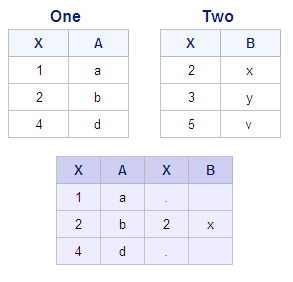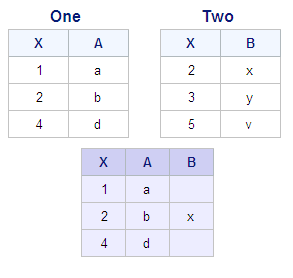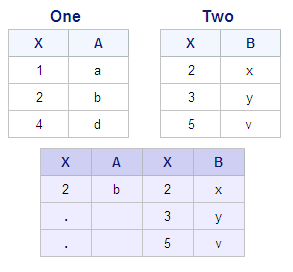Using Outer Joins
Introducing Types of Outer Joins
An outer join combines and displays all
rows that match across tables, based on the specified matching criteria
(also known as join conditions), plus some or all of the rows that
do not match. You can think of an outer join as an augmentation of
an inner join: an outer join returns all rows generated by an inner
join, plus additional (nonmatching) rows.
|
Type of Outer Join
|
Output
|
|---|---|
|
Left
|
All matching rows plus
nonmatching rows from the first table specified in the FROM clause
(the left table)
 |
|
Right
|
All matching rows plus
nonmatching rows from the second table specified in the FROM clause
(the right table)
 |
|
Full
|
All matching rows plus
nonmatching rows in both tables
 |
The syntax of an outer join
is shown below.
|
General form, SELECT
statement for outer join:
SELECT column-1<,...column-n>
FROM table-1
| view-1
LEFT
JOIN | RIGHT JOIN | FULL JOIN
table-2
| view-2
ON join-condition(s)
<other
clauses>;
LEFT JOIN, RIGHT JOIN, FULL JOIN
are keywords that specify
the type of outer join.
ON
specifies join-condition(s),
which are expression(s) that specify the column or columns on which
the tables are to be joined.
<other clauses>
refers to optional
PROC SQL clauses.
|
Note: To further subset the rows
in the query output, you can follow the ON clause with a WHERE clause.
The WHERE clause subsets the individual detail rows before the outer
join is performed. The ON clause then specifies how the remaining
rows are to be selected for output.
Note: You can perform an outer
join on only two tables or views at a time. Views are covered later
in this chapter.
Consider how each type
of outer join works.
Using a Left Outer Join
A left
outer join retrieves all rows that match across tables, based on the
specified matching criteria (join conditions), plus nonmatching rows
from the left table (the first table specified in the FROM clause).
Suppose you are using
the following PROC SQL left join to combine the two tables One and
Two. The join condition is stated in the expression following the
ON keyword. The two tables and the three rows of output are shown
below:
In each row of output,
the first two columns correspond to table One (the left table) and
the last two columns correspond to table Two (the right table).
Because this is a left
join, all rows (both matching and nonmatching) from table One (the
left table) are included in the output (the first two columns). Rows
from table Two (the right table) are displayed in the output (the
last two columns) only if they match a row from table One.
In this example, the
second row of output is the only row in which the row from table One
matched a row from table Two, based on the matching criteria (join
conditions) specified in the ON clause. In the first and third rows
of output, the row from table One had no matching row in table Two.
Note: In all three types of outer
joins (left, right, and full), the columns in the result (combined)
row that are from the unmatched row are set to missing values.
To eliminate one of
the duplicate columns (in this case, X) in any outer join, as shown
earlier with an inner join, you can modify the SELECT clause to list
the specific columns that is displayed. Here, the SELECT clause from
the preceding query has been modified to remove the duplicate X column:
Using a Right Outer Join
A right
outer join retrieves all rows that match across tables, based on the
specified matching criteria (join conditions), plus nonmatching rows
from the right table (the second table specified in the FROM clause).
Consider what happens
when you use a right join to combine the two tables used in the previous
example. The following PROC SQL query uses a right join to combine
rows from One and Two, based on the join conditions specified in the
ON clause:
In each row of output,
the first two columns correspond to table One (the left table) and
the last two columns correspond to table Two (the right table).
Because this is a right
join, all rows (both matching and nonmatching) from table Two (the
right table) are included in the output (the last two columns). Rows
from table One (the left table) are displayed in the output (the first
two columns) only if they match a row from table Two.
In this example, there
is only one row in table One that matches a value of X in table Two,
and these two matching rows combine to form the first row of output.
In the remaining rows of output, there is no match and the columns
corresponding to table One are set to missing values.
Using a Full Outer Join
A full
outer join retrieves both matching rows and nonmatching rows from
both tables.
Combine the same two
tables again, this time using a full join. The PROC SQL query, the
tables, and the output are shown below:
Because this is a full
join, all rows (both matching and nonmatching) from both tables are
included in the output. There is only one match between table One
and table Two, so only one row of output displays values in all columns.
All remaining rows of output contain only values from table One or
table Two. The remaining columns are set to missing values.
Example: Outer Join
Now that you have seen
how the three types of outer joins work, consider a realistic situation
requiring the use of an outer join.
Suppose you want to
list all of an airline's flights that were scheduled for March,
along with corresponding delay information (if it exists). Each flight
is identified by both a flight date and a flight number. Your output
should display the following data: flight date, flight number, destination,
and length of delay in minutes.
The data that you need
is stored in the two tables shown below. The applicable columns from
each table are identified.
|
Table
|
Relevant Columns
|
|---|---|
|
Sasuser.Marchflights
|
Date, FlightNumber,
Destination |
|
Sasuser.Flightdelays
|
Date, FlightNumber,
Destination, Delay |
Your output should include
the columns that are listed above and all of the following rows:
-
rows that have matching values of Date and FlightNumber across the two tables
-
rows from Sasuser.Marchflights that have no matching row in Sasuser.Flightdelays.
To generate the output
that you want, the following PROC SQL query uses a left outer join.
Sasuser.Marchflights is specified as the left (first) table.
proc sql outobs=20;
title 'All March Flights';
select m.date,
m.flightnumber
label='Flight Number',
m.destination
label='Left',
f.destination
label='Right',
delay
label='Delay in Minutes'
from sasuser.marchflights as m
left join
sasuser.flightdelays as f
on m.date=f.date
and m.flightnumber=
f.flightnumber
order by delay;Notice the following:
-
The SELECT clause eliminates the duplicate Date and FlightNumber columns by specifying their source as Sasuser.Marchflights. However, the SELECT clause list specifies the Destination columns from both tables and assigns a table alias to each to distinguish between them.
-
The ON clause contains two join conditions, which match the tables on the two columns Date and FlightNumber.
The query output is
shown below.
The first 12 rows of
output display rows from Sasuser.Marchflights (the left table) that
have no matching rows in Sasuser.Flightdelays. Therefore, in these
12 rows, the last 2 columns are set to missing values.
Note: The same results could be
generated by using a right outer join. Sasuser.Marchflights is specified
as the right (second) table.
..................Content has been hidden....................
You can't read the all page of ebook, please click here login for view all page.





